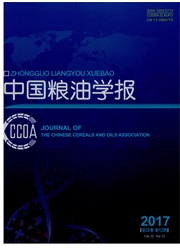

 中文摘要:
中文摘要:
应用傅里叶变换近红外光谱(FTNIR)结合化学计量学分别建立了芝麻油的真伪鉴别与掺伪定量的快速分析方法。真伪鉴别分别采用VTNIR结合主成分分析-簇类软独立模式识别(PCA-SIMCA)和偏最小二乘法-人工神经网络(PLS-ANN),建立了芝麻油、大豆油、花生油、葵花籽油的分类模型。经过验证,两种分类模型的准确识别率均达到了100%。芝麻油中掺伪油的定量分析采用FTNIR结合PLS。通过采集不同比例的芝麻油-大豆油与芝麻油-葵花籽油二元系统的FTNIR谱图,应用PLS分别建立二元系统定量分析模型并通过验证集检验其可靠性,研究结果表明该模型可以准确预测芝麻油中10%-100%的掺假油,其预测值与实际值的相对标准偏差(SEP)分别为1.027(大豆油)和0.9660(葵花籽油)。
 英文摘要:
英文摘要:
The rapidly analytical method has been established by Fourier transform near infrared spectroscopy (FFNIR) combined with chemometrics for the authenticity and quantity of sesame oil. FTNIR was combined with two types of authentication and recognition model to classify the sesame oil, soybean oil, peanut oil and sunflower oil by means of principal component analysis - soft independent modeling of class analogy ( PCA-SIMCA) and partial least squares-artificial neural network ( PLS-ANN) respectively. The results of two models are validated to be the correct recognition rate of 100%. FTNIR with PLS is used to quantify the adulterated sesame oil. Sesame oil with different proportions of soybean oil and sunflower oil were collected. FFNIR spectra PLS is used to establish the model of quan- titative analysis for testing its reliability through the validation set. The model can accurately predicts the sesame oil with 10% to 100% adulterated oil. the square error of prediction is 1. 027 ( soybean oil) and 0.966 0 ( sunflower oil), respectively.
 同期刊论文项目
同期刊论文项目
 同项目期刊论文
同项目期刊论文
 期刊信息
期刊信息
